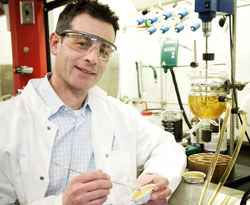Chemist works with smart materials

Chemist Philippe Merle is applying nanotechnology techniques to paint to develop a self-repairing coating.
andrew dobrowolskyj
In the same way that the body naturally heals cuts, some so-called “smart materials” are able to fill their own cracks. Concordia chemist Philippe G. Merle has been researching these materials, originally developed for use in space satellites, for several years to try to improve them. Now he has been awarded a grant from NanoQuébec, a provincial agency that funds nanotechnology research, to use the same technology in a new application: paint.
Merle, an assistant professor in the department of Chemistry and Biochemistry, collaborates on these projects with Mechanical and Industrial Engineering Professor Suong Van Hoa, director of the Concordia Centre for Composites. “I do the chemistry and synthesis (of the materials), and he tests their properties,” Merle explains.
Merle grew up in Montpellier, in the south of France, and got his undergraduate degree and PhD from the Université Montpellier II: Sciences et Techniques. He then did several years of postdoctoral work in France, England and the Netherlands before moving to Montreal in 2002.
When he first came to Concordia, Merle’s research interest focused on polymers (compounds with large molecules made up of repetitive structural units) and the chemical catalysts involved in their formation. He met Hoa when an engineering student of Hoa’s came to the chemistry department looking for help. She wanted access to a lab and equipment to learn more about the chemistry of the polymer materials she was studying.
Merle and Hoa collaborated on a research contract for MPB Communications Inc. and the Canadian Space Agency (CSA) to improve the self-repairing materials used in spacecraft.
“There are many objects flying around in space, especially tiny ones that can’t be detected and avoided; they can do a lot of damage to spacecraft,” Merle says.
Self-repairing smart materials were developed to deal with this problem. Tiny, glue-filled capsules and specks of a chemical catalyst are embedded throughout the polymer resin skin that covers satellites. If the resin is damaged, some of the capsules are torn open, releasing the liquid glue.
This technology has been around for more than 20 years, but Merle notes that it has limitations. The presence of the capsules decreases the strength of the resin. Another challenge is that spacecraft are exposed to heat when they face the sun and extreme cold when in the shade.
The Concordia researchers succeeded in reducing the size of the capsules, improving the ability of this material to withstand rapid temperature changes, and decreasing by one hundred-fold the amount of expensive catalyst embedded in the resin. They finished the contract in December, have applied for patents, and will present their results at an international conference in April.
Their next two-year $110,000 project is due to start this spring. MPB and Concordia are also contributing to this project, and Merle hopes to get an NSERC grant matching the NanoQuébec contribution.
“We propose to apply this technology to paints,” Merle explains. The idea is to implant tiny capsules containing an anti-rusting compound in paint. There would be a large market for this technology in paint used on ships’ hulls and bridge structures, for example. Merle and Hoa will be able to support at least two master’s students and hire several undergraduate students during the summer with this funding.
“I’ve done advanced academic research in chemistry, but I find it very satisfying to work on a specific application. When you work on contract with industry, you have to meet deadlines and produce significant results. That is very motivating.”